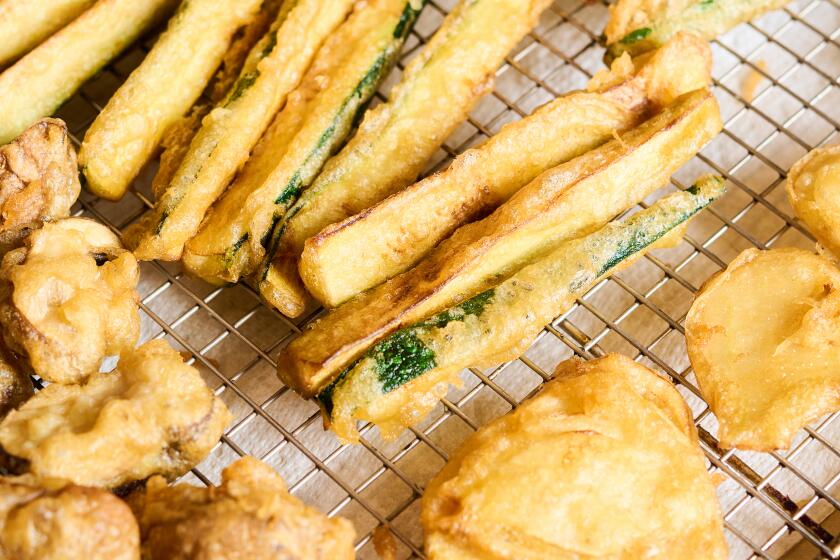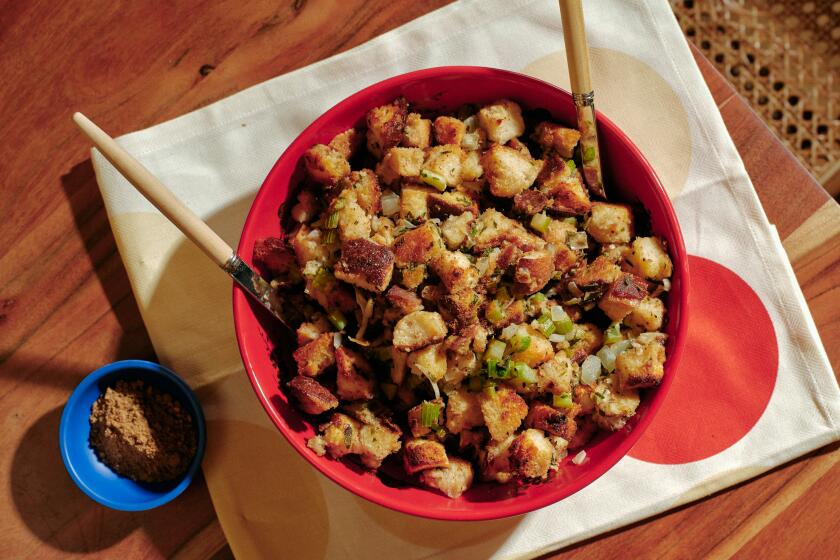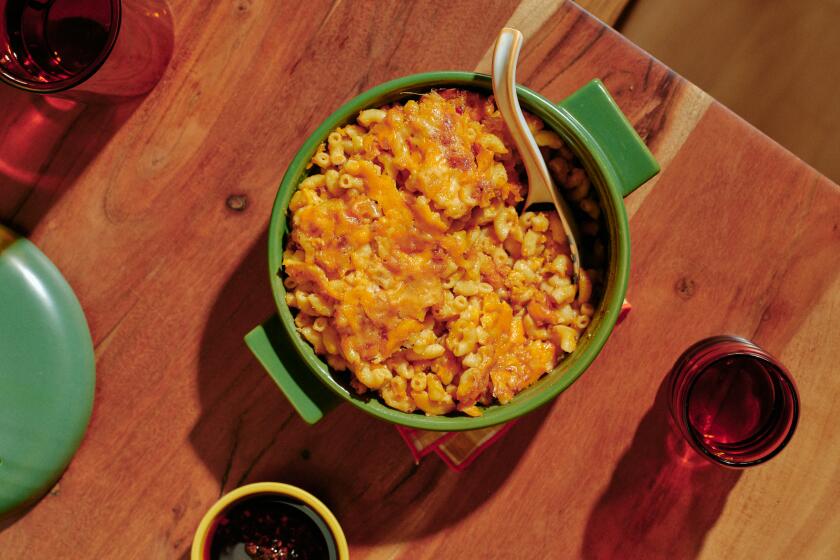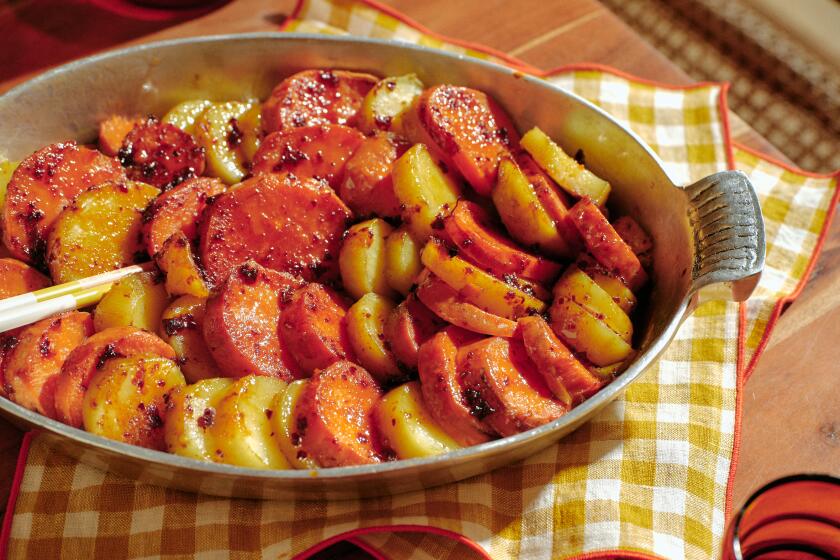Garlic risotto with baby broccoli

Last Wednesday at Union Square Greenmarket, the flagship farmers market of New York City’s Greenmarket network, only 23 farmers showed up. Who could blame them? It was 16 degrees at 8 a.m., and with the windchill factor, it felt like 5 degrees. They huddled inside trucks or heated tents.
In the worst weather, says spokeswoman Gabrielle Langholtz, many farmers simply stay home. “Even if they did have a gorgeous crop, there is no one to buy it,” she says. The few customers who braved the elements found some tubers and onions, a few apples, cultivated mushrooms, hothouse greens. “Nothing like what Californians get,” wrote a forlorn friend by e-mail. Many other frostbitten cities simply forgo the open-air markets until spring.
The scene is markedly different at the Wednesday Santa Monica farmers market. By 9 a.m., the streets are filled with produce lovers, mothers pushing strollers, immigrant grandmothers and chefs buying rainbow chard and pea shoots and chanterelles. Nearly 80 farmers set up stalls during winter months, and 10,000 customers -- toting baskets, wheeling carts or slinging canvas bags -- make the weekly pilgrimage. You don’t have to look hard to spot chefs: They’re the ones pushing overflowing carts, holding clipboards or wearing checked pants.
“I think it’s the best farmers market in the country,” says Gwen Gulliksen, vice president of ProAct Specialties, a cooperative of family-owned wholesale produce companies. She adds that it’s even better than the celebrated Ferry Plaza Market in San Francisco. That’s why her company procures fresh produce from Santa Monica for restaurants and food stores nationwide.
“We have fantastic things here all of the time,” says Gulliksen. “You can only have so many root vegetables.”
At the market’s southern end at 2nd Street, the improbable, intoxicating aroma of strawberries fills the air. The berries, big, plump and sweet, usually arrive in time for Valentine’s Day, but they’ve been in the market practically since the new year.
The signs of winter in L.A. are subtle. Ugg boots replace flip-flops, guys wear shorts with wool ski caps, and the pastry chefs buy citrus. Lots of citrus.
Elizabeth Belkind, pastry chef at Grace in Los Angeles, bought crates of Meyer lemons, kumquats and blood oranges so vivid, “they were like gems, like garnets,” she says. “You can basically change your whole dessert menu entirely to citrus.” On her menu, she’s been featuring a Meyer lemon timbale with a salad of blood oranges, Clementines and kumquats. She sauces it with a blood orange sauce, drizzles brown butter around and finishes it with Meyer lemon-poppy seed ice cream. (In the recipes that follow, Belkind replaces the timbale with a more user-friendly Meyer lemon poundcake.)
Betty B’s Ranch in Poway offered kumquats, orangequats (a larger, oblong cross between a kumquat and an orange), limequats (ditto, but crossed with lime) and something that looked like limes, though they were yellow. “They’re fully ripe limes,” said George T. Schnurer, owner of the ranch. They’re less tart, he explained, and more full flavored.
Across the way, Schaner Farms showed off pretty baskets of bumpy makrut limes and tiny yellow and green Mexican (Key) limes. Next door, Polito Family Farms had juicy, thin-skinned Meyer lemons, sweet Persian lemons, blushing blood oranges, compact mandarins bursting with flavor, tart pummelos the size of cabbages.
Bastide chef Alain Giraud chatted with Melisse’s Josiah Citrin over a basket of pepper cress at Maggie’s Farm. Citrin uses the cress to garnish his seared foie gras with walnut croquant and mandarin gastrique. He also bought baby artichokes and turnip greens for his steamed wild striped bass with artichoke fricassee, wilted turnip greens and Meyer lemon juice.
Citrin and Giraud are market regulars. Giraud brings two baskets -- one for the restaurant and one for home. For Bastide, he bought baby turnips to glaze and serve with duck breast; baby beets, Brussels sprouts and pattypan squash. Frilly chanterelle mushrooms will garnish Dover sole. He also picked up a few bunches of stinging nettles. His sous-chef, Kevin Meehan, makes a coulis with these, blanching equal amounts of nettles and baby spinach, pureeing them in a blender and mounting them with butter.
“When I was a kid, my grandma, who lived in a country house, used to go to pick them and add them in soup,” says Giraud. It’s easy to do the same at home, he says. Just make a simple leek and potato soup, add the nettles at the end, then puree.
Clementines and eucalyptus
Chef Joe Miller of Joe’s Restaurant in Venice is also a market fixture. He buys bunches of yellow, orange and red carrots to blanch in chicken stock with cipolline onions, and five kinds of grapefruit that he adds to a salad of blood oranges at Sunday brunch.
For his pastry chef, Mark Willard, Miller buys bundles of Clementines for a tangerine parfait with eucalyptus froth, toasted saffron and tangerine salsa. The “baby blue” eucalyptus comes from Coleman Farms.
Lately, Miller has discovered baby broccoli from McGrath Family Farms; Miller calls it “sprouting broccoli” on his menu. He serves it sauteed in olive oil over risotto with peppered pecorino cheese as an accompaniment to grilled hanger steak. The baby broccoli’s flavor is similar to rappini, but milder. According to Paul Thurston, the farm’s manager, the “babies” are tender, leafy side shoots from larger heads. The little things are also a pain to harvest -- hence the price, $4.75 a pound.
McGrath’s booth is a market favorite, particularly during the winter, because it features crisp organic lettuce, pea tendrils, rappini, mustard greens and red chard.
But the market is as much about community as it is about produce. The farmers, chefs and regular customers have drawn even closer in the aftermath of a car crash that killed 10 people last year. Friends meet for a blueberry scone at the Rockenwagner Bakery stall; chefs gather for coffee and gossip by the newsstand on the Promenade off Arizona after shopping.
In a few weeks, the shoppers will be on to the next stars of the season -- English peas, fava beans, perfect navel oranges and glorious, sweet Seascape and Gaviota strawberries.
Melt 4 tablespoons butter in a medium saucepan over medium heat. Add the onion and garlic and cook until soft, about 4 minutes. Add the rice and stir for 30 seconds to warm and coat the grains with butter.
Add the chicken stock in three equal parts, stirring the rice constantly to release the starches. Cook until the kernels are soft enough to eat but still have a bite to them, about 27 minutes.
Trim the tough bottom of each stalk of baby broccoli, and trim the larger outside leaves while leaving the smaller ones and the broccoli sprout. Blanch in a large pot of boiling, salted water until tender, about 2 minutes. Drain and toss in olive oil, salt and pepper.
To finish the risotto, stir in the remaining butter to make a creamy consistency. Spoon onto a plate and top the risotto with the baby broccoli. Top the vegetable and risotto mound with the sliced peppered pecorino.
Get our Cooking newsletter.
Your roundup of inspiring recipes and kitchen tricks.
You may occasionally receive promotional content from the Los Angeles Times.














